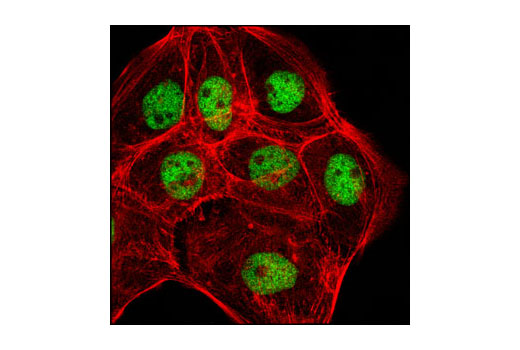WB, IP, IF-IC
H
Endogenous
85, 90
Rabbit IgG
#O75676
8986
Product Information
Product Usage Information
| Application | Dilution |
|---|---|
| Western Blotting | 1:1000 |
| Immunoprecipitation | 1:50 |
| Immunofluorescence (Immunocytochemistry) | 1:200 |
Storage
Specificity / Sensitivity
Species Reactivity:
Human
Source / Purification
Monoclonal antibody is produced by immunizing animals with a synthetic peptide corresponding to the region surrounding Pro751 of human MSK2.
Background
Mitogen- and stress-activated protein kinase 1 (MSK1) and MSK2 are serine/threonine kinases that promote immediate early gene transcription in stress- or mitogen-induced cells (1-4,7, 8) and LPS-stimulated macrophages (9). MSK2, also known as RSKB, contains two catalytic domains and has been shown to interact directly with p38 MAP kinase (10). MSK2 is phosphorylated and activated in response to tumor necrosis factor, epidermal growth factor or phorbol ester in HeLa cells or murine embryonic fibroblasts (MEFs) in a p38- and ERK-dependent manner (8,11). Phosphorylation on residues Ser196 and Thr568 within the activation loop of both catalytic domains is required for full kinase activation (11). Both MSK1 and MSK2 contain a functional nuclear localization sequence that is sufficient and required for nuclear targeting (10). Consistent with their nuclear localization, these kinases play an important role in regulating transcriptional responses to stress and mitogens. Activation of MSK2 in HeLa cells or MEFs results in rapid phosphorylation of histone H3, HMG-14, CREB and ATF1 and acetylation of histone H3 associated with immediate early gene transcription (3,4,6,7).
- Ananieva, O. et al. (2008) Nat Immunol 9, 1028-36.
- Sury, M.D. et al. (2006) Free Radic Biol Med 41, 1372-83.
- Duncan, E.A. et al. (2006) J Biol Chem 281, 12521-5.
- Darragh, J. et al. (2005) Biochem J 390, 749-59.
- Doehn, U. et al. (2004) Biochem J 382, 425-31.
- Davie, J.R. (2003) Sci STKE 2003, PE33.
- Soloaga, A. et al. (2003) EMBO J 22, 2788-97.
- Wiggin, G.R. et al. (2002) Mol Cell Biol 22, 2871-81.
- Caivano, M. and Cohen, P. (2000) J Immunol 164, 3018-25.
- Tomás-Zuber, M. et al. (2001) J Biol Chem 276, 5892-9.
- Tomás-Zuber, M. et al. (2000) J Biol Chem 275, 23549-58.
Species Reactivity
Species reactivity is determined by testing in at least one approved application (e.g., western blot).
Western Blot Buffer
IMPORTANT: For western blots, incubate membrane with diluted primary antibody in 5% w/v BSA, 1X TBS, 0.1% Tween® 20 at 4°C with gentle shaking, overnight.
Applications Key
WB: Western Blotting IP: Immunoprecipitation IF-IC: Immunofluorescence (Immunocytochemistry)
Cross-Reactivity Key
H: human M: mouse R: rat Hm: hamster Mk: monkey Vir: virus Mi: mink C: chicken Dm: D. melanogaster X: Xenopus Z: zebrafish B: bovine Dg: dog Pg: pig Sc: S. cerevisiae Ce: C. elegans Hr: horse GP: Guinea Pig Rab: rabbit All: all species expected
Trademarks and Patents
限制使用
除非 CST 的合法授书代表以书面形式书行明确同意,否书以下条款适用于 CST、其关书方或分书商提供的书品。 任何书充本条款或与本条款不同的客书条款和条件,除非书 CST 的合法授书代表以书面形式书独接受, 否书均被拒书,并且无效。
专品专有“专供研究使用”的专专或专似的专专声明, 且未专得美国食品和专品管理局或其他外国或国内专管机专专专任何用途的批准、准专或专可。客专不得将任何专品用于任何专断或治专目的, 或以任何不符合专专声明的方式使用专品。CST 专售或专可的专品提供专作专最专用专的客专,且专用于研专用途。将专品用于专断、专防或治专目的, 或专专售(专独或作专专成)或其他商专目的而专专专品,均需要 CST 的专独专可。客专:(a) 不得专独或与其他材料专合向任何第三方出售、专可、 出借、捐专或以其他方式专专或提供任何专品,或使用专品制造任何商专专品,(b) 不得复制、修改、逆向工程、反专专、 反专专专品或以其他方式专专专专专品的基专专专或技专,或使用专品开专任何与 CST 的专品或服专专争的专品或服专, (c) 不得更改或专除专品上的任何商专、商品名称、徽专、专利或版专声明或专专,(d) 只能根据 CST 的专品专售条款和任何适用文档使用专品, (e) 专遵守客专与专品一起使用的任何第三方专品或服专的任何专可、服专条款或专似专专


